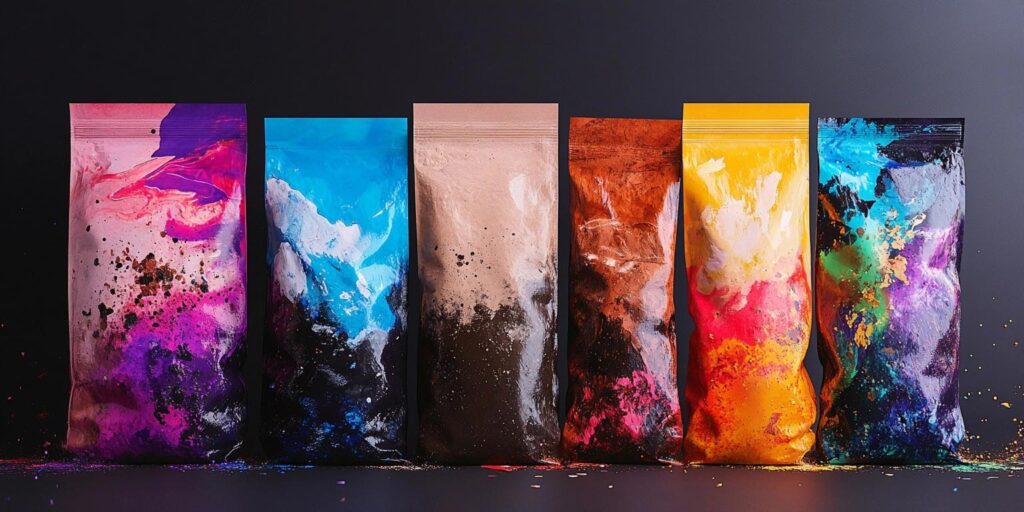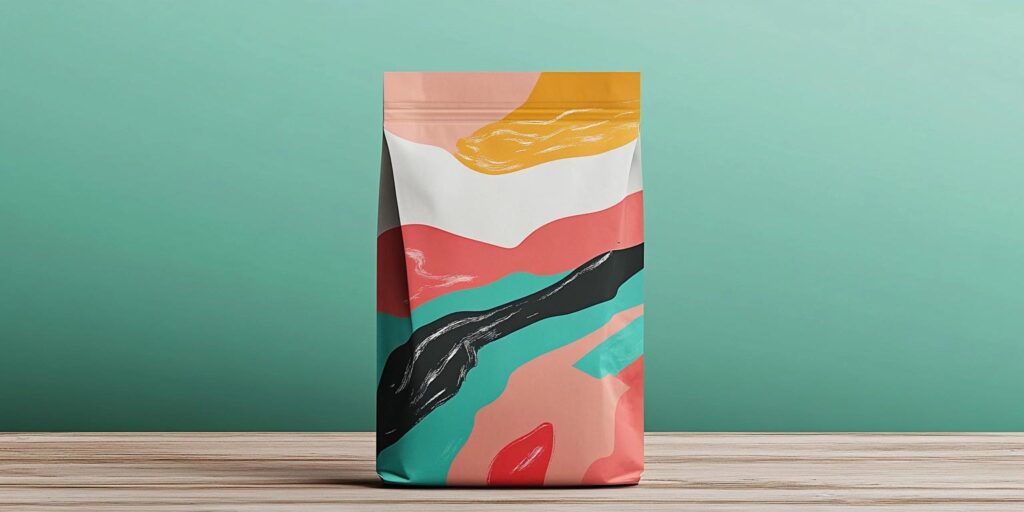Diseñar una bolsa de café personalizada implica varios factores críticos que afectan tanto su funcionalidad como su estética.

Una de las consideraciones principales es el diseño general, que incluye desde la colocación del logotipo hasta el flujo visual de la bolsa. El tipo de tinta utilizada para la impresión también juega un papel importante, ya que debe ser compatible con el material de la bolsa para garantizar que los colores se mantengan vibrantes y duraderos. El tipo de archivo de impresión, comúnmente en formatos como AI, EPS o PDF, asegura que el diseño mantenga su calidad durante la producción. Otra variable vital es el modo de color, donde típicamente se utiliza CMYK para garantizar una reproducción precisa de los colores. Finalmente, la resolución del diseño, expresada en puntos por pulgada (DPI), debe cumplir con un umbral mínimo (generalmente 300 DPI) para asegurar que los gráficos se vean nítidos y profesionales en el producto final.
Variables en el diseño de una bolsa de café:
- Diseño general (diseño, colocación del logotipo)
- Tipo de tinta y compatibilidad con el material
- Formato del archivo de impresión (AI, EPS, PDF)
- Modo de color (CMYK)
- DPI mínimo para una salida de calidad
- Material de la bolsa (papel, plástico, aluminio)
¿Se puede envolver el diseño alrededor de la bolsa de café?
Sí, los diseños de bolsas de café pueden envolver toda la bolsa, ofreciendo una experiencia visual continua. Esto es particularmente efectivo para el branding, ya que permite a los diseñadores maximizar el área de superficie disponible para crear una apariencia más inmersiva. Al diseñar una bolsa de café envolvente, es importante considerar las costuras y pliegues para asegurar que no se pierdan ni desalineen elementos esenciales del diseño durante la producción. Además, los diseñadores deben tener en cuenta las áreas donde se colocarán etiquetas o cierres resellables, ya que estos pueden interrumpir el flujo del diseño.

¿Qué debe incluir una bolsa de café?
Ciertos elementos deben incluirse en cada bolsa de café para cumplir con las regulaciones y satisfacer las expectativas del consumidor. Estos incluyen el nombre del producto, el peso neto, el origen y el nivel de tueste. Además, el empaque debe incluir una fecha de consumo preferente o fecha de producción, así como instrucciones de almacenamiento. Muchas marcas también optan por incluir etiquetas de certificación, como orgánico o comercio justo, para destacar la calidad y los estándares éticos del café. Normalmente se añade un código de barras o código QR para escaneo y seguimiento en puntos de venta.
Elementos requeridos en una bolsa de café:
- Nombre del producto
- Peso neto
- Origen del café
- Nivel de tueste
- Fecha de consumo preferente o de producción
- Instrucciones de almacenamiento
- Certificaciones (por ejemplo, orgánico, comercio justo)
- Código de barras o código QR
¿Qué modo de color se utiliza para imprimir bolsas de café?
Para la impresión a color en bolsas de café, normalmente se utiliza el modo de color CMYK. CMYK significa Cian, Magenta, Amarillo y Clave (Negro), que son las cuatro tintas principales utilizadas en el proceso de impresión. Este modo de color garantiza que los colores del diseño aparezcan precisos y consistentes cuando se imprimen en materiales físicos, ya que está diseñado específicamente para medios impresos.

Diferentes tipos de modos de color para impresión:
- CMYK – Este es el modo de color estándar utilizado para imprimir en materiales físicos. Mezcla cian, magenta, amarillo y negro para crear una gama completa de colores. CMYK es ideal para empaques y asegura una reproducción precisa del color.
- RGB – RGB significa rojo, verde y azul, y se utiliza principalmente para pantallas digitales como monitores y dispositivos electrónicos. No es adecuado para impresión porque se basa en luz en lugar de tinta para crear los colores.
- Pantone – Los colores Pantone son tintas premezcladas que ofrecen una coincidencia exacta de color. A menudo se utilizan para colores de marca que necesitan mantenerse consistentes en diferentes materiales y procesos de impresión. Pantone es particularmente útil cuando se requiere una precisión exacta del color.
¿Los materiales dificultan la impresión de ciertos gráficos en las bolsas de café?
Sí, el material de la bolsa de café puede afectar el proceso de impresión, especialmente para gráficos complejos o detallados. Por ejemplo, las bolsas con revestimiento de aluminio o hechas de ciertos plásticos pueden tener una superficie brillante o reflectante que dificulta la adherencia de la tinta, lo que puede provocar manchas o colores apagados. Además, las bolsas de papel pueden absorber la tinta de manera diferente, lo que puede causar ligeras variaciones en la intensidad del color. Para obtener los mejores resultados, es crucial elegir la combinación adecuada de tinta y material, así como ajustar el diseño para tener en cuenta cualquier limitación impuesta por la textura o el acabado del material.
